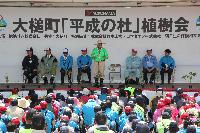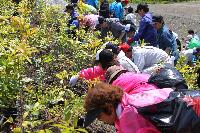News Release
Yokohama Rubber Holds Second-Phase Tree Planting in Otsuchi-cho, Iwate Prefecture, 5,000 Trees Planted by Local Residents and Others
2013.May.24
- Management relation
- Sustainability relation
Tokyo - The Yokohama Rubber Co., Ltd., announced today that it carried out a "Heisei Forest" tree planting on May 18 to help support recovery of Otsuchi-cho, Kamihei-gun, Iwate Prefecture, one of the areas affected by the Great East Japan Earthquake. 553 participants, including 160 Otsuchi-cho residents, planted about 5,000 broad-leaved evergreen seedlings indigenous to the local area. Together with guests, including Otsuchi Mayor Yutaka Ikarigawa, representatives of supporting companies, Dr. Akira Miyawaki (plant ecologist) and former F1 driver Mr. Ukyo Katayama, 245 people from Yokohama Rubber attended the event, including Chairman and CEO Tadanobu Nagumo, President Hikomitsu Noji and 54 employee volunteers.
Otsuchi-cho promotes creation of "Forests That Protect Lives" as part of its recovery plan. In support, on April 30, 2012, Yokohama Rubber carried out a model-forest tree planting in the town under its Yokohama Forever Forest Project. This day's event was the second-phase planting. A new 250-meter extension was created to the 50-meter mound where seedlings were planted last year, and the planting this time was in a 50-meter portion of the new mound. Hereafter, Yokohama Rubber will carry out further tree plantings in 50-meter areas each year, completing planting of the 300-meter mound by 2017, the year the company will mark its 100th anniversary. The first-phase model forest was renamed "Heisei Forest" - from "Forever Forest" - so that the great earthquake that occurred in the Heisei period will never be forgotten.
The primary, distinctive feature of the "Heisei Forest" is that the underlying mound was, except for the topsoil, created from disaster debris - woody debris (only natural wood, not construction materials), earth and sand, and non-combustible earthy debris such as concrete pieces. Use of disaster debris not only helps reduce the cost of its disposal and CO2 emissions from incineration, but will actually facilitate the growth of the seedlings. Looking to the creation of more "Forests That Protect Lives" hereafter, Yokohama Rubber will continue to regularly take measurements and carry out investigations at the site of the first-phase tree planting, to determine and understand quantitatively the effects of using disaster debris.
The Yokohama Rubber Group has been carrying out the Yokohama Forever Forest Project since 2007, largely on the initiative of its employees, under the guidance of Dr. Akira Miyawaki, plant ecologist and professor emeritus of Yokohama National University. Conceived by him, "Forests That Protect Lives" is an effort to create "genuine" or "native" forests that will withstand tsunami along the 300-kilometer Pacific coast in the Tohoku region. Dr. Miyawaki advocates effective use of disaster debris in mounds created for planting.
Messages from Selected Participants (Summarized)
Otsuchi Mayor Yutaka Ikarigawa
Approached by Dr. Miyawaki to create a green embankment, the town has been fostering "Forests That Protect Lives" since April last year. We will steadily endeavor to build the "Heisei Forest" as our effort to never let the disaster - in which one in ten town residents died - fade from memory; to provide repose for the souls of the deceased; and to make it eventually a place of recreation and relaxation for our citizens. With the landside of a 14.5-meter-high concrete embankment covered with the "Heisei Forest," we will re-create a town that is at the same time both environmentally friendly and protects people from disaster. Toward eventual reconstruction of the town, recovery work, little by little, has been making steady progress. For example, 124 units of "disaster-recovery public housing" will soon be ready for occupancy. We owe this to staff coming from all over the country, and to all the people here for their support. We are extremely grateful. With the nice weather we are having, I hope you will conduct today's planting with these ideas in your heart.
Yokohama Rubber's Chairman and CEO Tadanobu Nagumo
In support of creating forests that will provide repose for deceased souls, part of the recovery program determined by Otsuchi-cho, Yokohama Rubber carried out a first-phase model-forest tree planting last year. As you can see, those seedlings have grown rapidly and are now about a meter tall. Today's is the second-phase planting and the forest is now to be known as the "Heisei Forest" in order that people may never forget the unprecedented great earthquake. We will plant about 5,000 trees every year and expect the 300-meter mound to be fully covered in green by 2017, when the company will mark its 100th anniversary. We hope that this 300-meter green mound will convey Otsuchi-cho residents' thoughts for the deceased souls whenever people look at it. We are also asking those living in temporary housing to grow seedlings from seeds. Those seedlings, too - and those people's feelings and thoughts - will be planted in the "Heisei Forest." We look forward in the near future to its becoming truly a forest that protects lives.
Yokohama Rubber's President Hikomitsu Noji
All your efforts today are very deeply appreciated. Recently I visited our plant in the Philippines, where we had a tree planting five years ago. The trees I saw are ten meters tall now. So I want to ask you to take good care of the seedlings you planted today. As you know, the name is now “Heisei Forest.” When Dr. Miyawaki met the Emperor in July last year and asked for permission to use “Heisei,” the Emperor was most pleased. The name was then changed from “Forever Forest,” but the idea of connecting lives and preserving DNA remains a part of it. We have asked people living in temporary housing in the town to grow seedlings. We also grow seedlings at our company locations, including our Shinshiro, Mie and Onomichi Plants. Because planted trees have to be indigenous to the local area, we will gather seeds from this area in the fall and plant them in pots. We would appreciate your support for that, too, and into the future.




